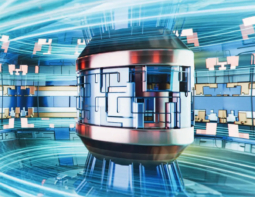

High-precision laser spectroscopy measurements on the thorium-229 nucleus could reveal new physics, say TU Wien physicists
New technique could shed light on electrification of aerosols
"Beamforming feedback information" in latest version of the technology can identify individuals passing through radio networks with almost 100% accuracy, say researchers
Having more antimatter could help solve profound mysteries of physics
 Read article: Sympathetic cooling gives antihydrogen experiment a boost
Read article: Sympathetic cooling gives antihydrogen experiment a boost
Research could lead to ultracompact muon sources for applications such as tomography
 Read article: Portable source could produce high-energy muon beams
Read article: Portable source could produce high-energy muon beams
Compact system outperforms astronomical spectrometers
 Read article: Randomly textured lithium niobate gives snapshot spectrometer a boost
Read article: Randomly textured lithium niobate gives snapshot spectrometer a boost
Novel imaging technique can find objects buried within in opaque environments, including biological tissues
 Read article: Fingerprint method can detect objects hidden in complex scattering media
Read article: Fingerprint method can detect objects hidden in complex scattering media
Advanced seismic imaging techniques could improve earthquake early warning models and aid the development of next-generation geothermal power
 Read article: Scientists obtain detailed maps of earthquake-triggering high-pressure subsurface fluids
Read article: Scientists obtain detailed maps of earthquake-triggering high-pressure subsurface fluids
Global network could pinpoint astronomical sources
 Read article: Phase shift in optical cavities could detect low-frequency gravitational waves
Read article: Phase shift in optical cavities could detect low-frequency gravitational waves
Science is done in just about every corner of the globe but many researchers lack access to the cutting-edge instrumentation available at large facilities such as synchrotron light sources and neutron-science centres. Widening this accessibility is an important theme running through this free-to-read briefing.

Europe’s largest event for electronics manufacturing comes to Munich on 18−21 November, 2025
 Read article: SEMICON Europa 2025 presents cutting-edge technology for semiconductor R&D and production
Read article: SEMICON Europa 2025 presents cutting-edge technology for semiconductor R&D and production
New algorithm turns structured motion into sharper images
 Read article: Motion blur brings a counterintuitive advantage for high-resolution imaging
Read article: Motion blur brings a counterintuitive advantage for high-resolution imaging
With further improvements, the instrument could enable direct tests of relativistic effects
 Read article: Optical gyroscope detects Earth’s rotation with the highest precision yet
Read article: Optical gyroscope detects Earth’s rotation with the highest precision yet
Built on UHV Design’s Production Linear Shift Mechanism range (PLSM), new linear actuator allows heavy objects to be moved very smoothly, says UHV Design engineering director Jonty Eyres
 Read article: A low vibration wire scanner fork for free electron lasers
Read article: A low vibration wire scanner fork for free electron lasers
Gabriel Lippmann received the Nobel Prize for Physics in 1908 for a new method of colour photography that was never commercially successful. Margaret Harris finds out why
 Read article: Nobel prizes you’ve never heard of: how an obscure version of colour photography beat quantum theory to the most prestigious prize in physics
Read article: Nobel prizes you’ve never heard of: how an obscure version of colour photography beat quantum theory to the most prestigious prize in physics
Real-time system also detects ebb and flow of tides
 Read article: Cosmic muons monitor river sediments surrounding Shanghai tunnel
Read article: Cosmic muons monitor river sediments surrounding Shanghai tunnel
Machine learning system reduces noise in interferometer mirrors
 Read article: LIGO could observe intermediate-mass black holes using artificial intelligence
Read article: LIGO could observe intermediate-mass black holes using artificial intelligence
Smartphone-based approach could supplement existing seismic detector networks
 Read article: Android phone network makes an effective early warning system for earthquakes
Read article: Android phone network makes an effective early warning system for earthquakes
New design is more efficient at driving electrons
 Read article: New laser-plasma accelerator could soon deliver X-ray pulses
Read article: New laser-plasma accelerator could soon deliver X-ray pulses
New ultrafast optical microscope could aid the development of advanced optoelectronic devices and quantum technologies based on these nanomaterials
 Read article: Scientists image excitons in carbon nanotubes for the first time
Read article: Scientists image excitons in carbon nanotubes for the first time
Cryogenic architecture supports tighter integration
 Read article: Spin-qubit control circuit stays cool
Read article: Spin-qubit control circuit stays cool
Certain types of quantum clocks could circumvent thermal dissipation, say physicists
 Read article: How to keep the second law of thermodynamics from limiting clock precision
Read article: How to keep the second law of thermodynamics from limiting clock precision
New architecture could be used to create tailored devices that emit or receive only certain frequencies of sound
 Read article: Acoustic rainbows emerge from novel sound-scattering structure
Read article: Acoustic rainbows emerge from novel sound-scattering structure
Quantum image sensor-based device could be used to observe living cells
 Read article: New ‘telescope-microscope’ detects extremely low levels of light
Read article: New ‘telescope-microscope’ detects extremely low levels of light
Scanning-tunnelling microscope with a superconducting tip could help uncover materials for next-generation quantum computers
 Read article: New microscopy technique can identify topological superconductors
Read article: New microscopy technique can identify topological superconductors
Fibre and satellites connections span two continents
 Read article: New definition of second ticks closer after international optical-clock comparison
Read article: New definition of second ticks closer after international optical-clock comparison
Pulse-tube cryocooler and innovative design deliver shorter cooling times and larger experimental payloads
 Read article: New optical cryostat combines high cooling capacity, low vibrations and large sample area
Read article: New optical cryostat combines high cooling capacity, low vibrations and large sample area
Simulations suggest that new design could deliver gigaelectronvolt protons
 Read article: Micronozzle could give laser-driven particle accelerators a boost
Read article: Micronozzle could give laser-driven particle accelerators a boost